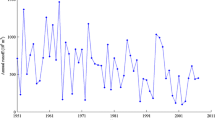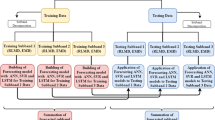Abstract
Annual runoff forecasting remains a difficult task due to its complicated non-stationary characteristics. To solve this difficulty and improve the prediction accuracy, this paper proposes a novel hybrid model for annual runoff forecasting. This model is based on the ensemble empirical mode decomposition (EEMD) and Auto-Regressive (AR). And it is suitable for non-stationary time series. The proposed model is tested using the annual runoff data from four hydrologic stations in the upper reaches of the Fenhe River basin in China. The non-stationary original annual runoff time series is first decomposed into a limited number of intrinsic mode functions (IMFs) and one trend term using EEMD technique for making the time series stationary. Then, these IMFs are forecasted by establishing corresponding optimum AR models only stationary processes, and trend term is predicted by quadratic polynomial equation. At last, the prediction results of the modeled IMFs and trend term are summed to formulate an ensemble forecast for the original runoff series. The performance of the EEMD-AR hybrid model is compared with EMD-AR and single AR models. Results indicate that EEMD-AR hybrid model gives better accuracy in predicting annual runoff in the study area when compared to other models.




Similar content being viewed by others
References
Arya FK, Zhang L (2015) Time series analysis of water quality parameters at Stillaguamish river using order series method. Stoch Env Res Risk A 29(1):227–239
Bao Y, Wang H, Wang BN (2014) Short-term wind power prediction using differential EMD and relevance vector machin. Neural Comput Appl 25(2):283–289
Behzad M, Asghari K, Eazi M, Palhang M (2009) Generalization performance of support vector machines and neural networks in runoff modeling. Expert Syst Appl 36(4):7624–7629
Chen YN, Xu ZX (2005) Plausible impact of global climate change on water resources in the Tarim river basin. Sci China Ser D 48(1):65–73
Di CL, Yang XH, Wang XC (2014) A four-stage hybrid model for hydrological time series forecasting. PloS One 9(8):E104663. doi:10.1371/journal.pone.0104663
Guner B, Frankford MT, Johnson JT (2009) A study of the Shapiro-Wilk test for the detection of pulsed sinusoidal radio frequency interference. IEEE T Geosci Remote 47(6):1745–1751
Guo J, Zhou JZ, Qin H, Zou Q, Li QQ (2011) Monthly streamflow forecasting based on improved support vector machine model. Expert Syst Appl 38(10):13073–13081
Hanusz Z, Tarasinska J (2014) Simulation study on improved Shapiro-Wilk tests for normality. Commun Stat-Simul 43(9):2093–2105
Harvey DI, Leybourne SJ, Taylor AMR (2014) On infimum Dickey-Fuller unit root tests allowing for a trend break under the null. Comput Stat Data An 78:235–242
Hu JM, Wang JZ, Zeng GW (2013) A hybrid forecasting approach applied to wind speed time series. Renew Energ 60:185–194
Huang NE, Wu ZH (2008) A review on Hilbert-Huang transform: method and its applications to geophysical studies. Rev Geophys 46(2):RG2006. doi:10.1029/2007RG000228
Huang SZ, Chang JX, Huang Q, Chen YT (2014) Monthly streamflow prediction using modified EMD-based support vector machine. J Hydrol 511:764–775
Huang YX, Schmitt FG, Lu ZM, Liu YL (2009) Analysis of daily river flow fluctuations using empirical mode decomposition and arbitrary order Hilbert spectral analysis. J Hydrol 373(1–2):103–111
Islam A, Sikka AK, Saha B, Singh A (2012) Streamflow response to climate change in the Brahmani river basin, India. Water Resour Manag 26(6):1409–1424
Kallas M, Honeine P, Francis C, Amoud H (2013) Kernel autoregressive models using Yule-Walker equations. Signal Process 93(11):3053–3061
Kisi O, Latifoglu L, Latifoglu F (2014) Investigation of empirical mode decomposition in forecasting of hydrological time series. Water Resour Manag 28(12):4045–4057
Lafdani EK, Nia AM, Ahmadi A (2013) Daily suspended sediment load prediction using artificial neural networks and support vector machines. J Hydrol 478:50–62
Li HY, Tian L, Wu YN, **e M (2013) Improvement of mid- to long-term runoff forecasting based on physical causes: application in Nenjiang basin, China. Hydrolog Sci J 58(7):1414–1422
Liu DT, Luo Y, Liu J, Peng Y, Guo LM, Pecht M (2014a) Lithium-ion battery remaining useful life estimation based on fusion nonlinear degradation AR model and RPF algorithm. Neural Comput Appl 25(3–4):557–572
Liu W, He K, Gao Q, Liu CY (2014b) Application of EMD-based SVD and SVM to coal-gangue interface detection. J Appl Math. doi:10.1155/2014/283606
Lu CJ, Shao YJE (2012) Forecasting computer products sales by integrating ensemble empirical mode decomposition and extreme learning machine. Math Probl Eng. doi:10.1155/2012/831201
Makwana JJ, Tiwari MK (2014) Intermittent streamflow forecasting and extreme event modelling using wavelet based artificial neural networks. Water Resour Manag 28(13):4857–4873
Ministry of Water Resources (2000) SL250–2000, Standard for hydrological information and hydrological forecasting. Ministry of Water Resources, Bei**g
Nourani V, Baghanam AH, Adamowski J, Kisi O (2014) Applications of hybrid wavelet-Artificial Intelligence models in hydrology: a review. J Hydrol 514:358–377
Royston P (1992) Approximating the Shapiro-Wilk W-test for non-normality. Stat Comput 2(3):117–119
Sanikhani H, Kisi O (2012) River flow estimation and forecasting by using two different adaptive Neuro-Fuzzy approaches. Water Resour Manag 26(6):1715–1729
Shapiro SS, Wilk MB (1965) An analysis of variance test for normality (complete samples). Biometrika 52(3–4):591–611
Tang L, Yu LA, Wang S, Li JP, Wang SY (2012) A novel hybrid ensemble learning paradigm for nuclear energy consumption forecasting. Appl Energ 93(SI):432–443
Wang HJ, Zhao WG (2009) ARIMA model estimated by particle swarm optimization algorithm for consumer price index forecasting. Artif Intel Comput Intel 5855:48–58
Wang WC, Xu DM, Chau KW, Chen SY (2013) Improved annual rainfall-runoff forecasting using PSO-SVM model based on EEMD. J Hydroinform 15(4):1377–1390
Wang WS, Ding D, ** JL (2008) Stochastic hydrology. Bei**g, China
Wu ZH, Huang NE, Long SR, Peng CK (2007) On the trend, detrending, and variability of nonlinear and nonstationary time series. Proc Natl Acad Sci U S A 104(38):14889–14894
Yao JQ, Liu ZH, Yang Q, Meng XY, Li CZ (2014) Responses of runoff to climate change and human activities in the Ebinur Lake catchment, Western China. Water Resour 41(6):738–747
Yevjevich V (1972) Stochastic process in hydrology. Water Resources Publications, Colorado
Zhan CS, Zeng SD, Jiang SS, Wang HX, Ye W (2014) An integrated approach for partitioning the effect of climate change and human activities on surface runoff. Water Resour Manag 28(11):3843–3858
Zhan DJ, Ye SZ (2008) Engineering hydrology. Bei**g, China
Zhang Q, Singh VP, Li K, Li JF (2014) Trend, periodicity and abrupt change in streamflow of the East River, the Pearl river basin. Hydrol Process 28(2):305–314
Zhang Q, Wang BD, He B, Peng Y, Ren ML (2011) Singular spectrum analysis and ARIMA hybrid model for annual runoff forecasting. Water Resour Manag 25(11):2683–2703
Zhang XQ, Liang J (2013) Chaotic time series prediction model of wind power based on ensemble empirical mode decomposition-approximate entropy and reservoir. Acta Phys Sin 62(5) doi:10.7498/aps.62.050505
Zhao CS, Liu CM, Dai XQ, Liu T, Duan Z, Liu LF, Mitrovic SM (2015) Separation of the impacts of climate change and human activity on runoff variations. Hydrol Sci J 60(2):234–246
Acknowledgments
Sincere gratitude is extended to the editors and anonymous reviewers for their professional comments and corrections, which greatly improved the presentation of the paper. This research is financially supported by the National Natural Science Foundation of China (Grant Nos. 40901018, 51190093), Science and Technology Key Project on Social Development of Shanxi Province (20140313023–4), Youth Team Foundation Project of Taiyuan University of Technology (Grant No. 2013 T039), and Program for the Top Young Academic Leaders of Higher Learning Institutions of Shanxi.
Author information
Authors and Affiliations
Corresponding author
Rights and permissions
About this article
Cite this article
Zhao, Xh., Chen, X. Auto Regressive and Ensemble Empirical Mode Decomposition Hybrid Model for Annual Runoff Forecasting. Water Resour Manage 29, 2913–2926 (2015). https://doi.org/10.1007/s11269-015-0977-z
Received:
Accepted:
Published:
Issue Date:
DOI: https://doi.org/10.1007/s11269-015-0977-z




